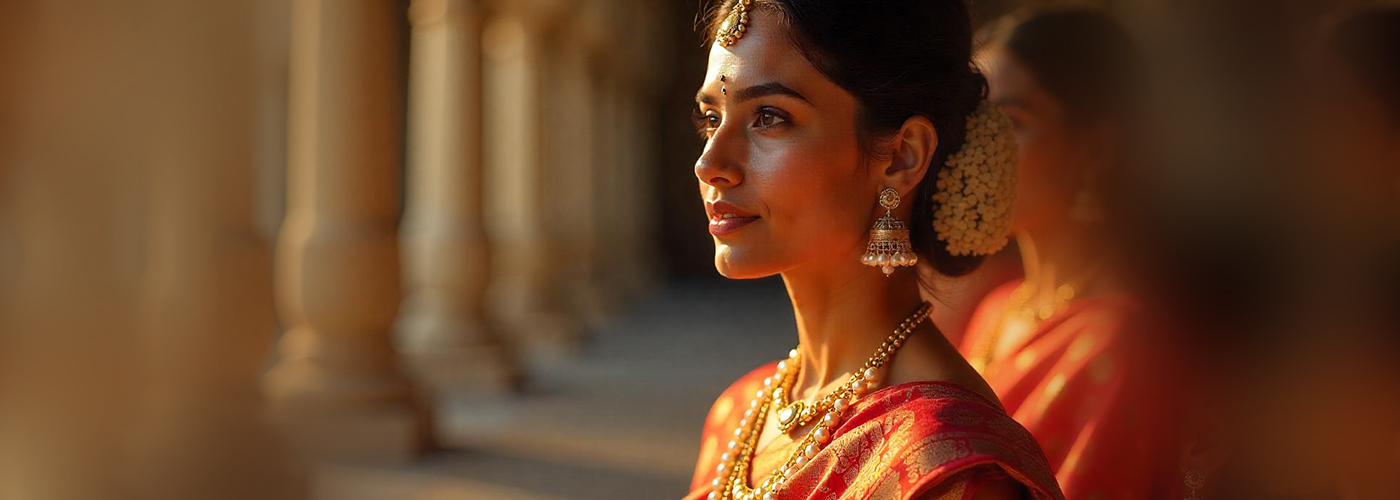Maharashtrian jewellery, like the vibrant culture it adorns, boasts a rich and fascinating history. From its deep-rooted traditional significance to its
contemporary adaptations, the evolution of these ornaments reflects the changing times while staying true to its unique identity.
Echoes of Tradition:
Historically, Maharashtrian jewellery was deeply intertwined with social customs, religious beliefs, and regional influences. Crafted primarily in gold, these pieces were not merely adornments but also symbols of status, prosperity, and marital status.
- The Nath (Nose Ring): Perhaps the most iconic piece, the nath, with its intricate designs often featuring pearls, rubies, and emeralds, is a powerful symbol of a married woman. Its various regional styles, like the Peshwai nath or the Kolhapuri nath, speak volumes about local traditions.
- The Thushi (Gold Bead Necklace): This tightly woven necklace of golden beads, often adjustable with a drawstring, was a staple. Its simple yet elegant design held significant cultural value.
- The Mohan Mala (Coin Necklace): Featuring gold coins strung together, the mohan mala represented wealth and prosperity. The coins often bore historical imprints, adding to their significance.
- Bajuband and Armlets: Intricately carved armlets, known as bajuband, were worn by both men and women, signifying strength and status.
- Ear Ornaments: A variety of ear ornaments, including kundal (studs), bali (hoops), and vel (intricate climbers), were integral to the traditional ensemble.
Influences and Transformations:
Over time, Maharashtrian jewellery absorbed influences from various periods and rulers. The Maratha empire’s grandeur is reflected in the opulent designs and the use of precious stones. Later, interactions with other cultures led to subtle changes in craftsmanship and aesthetics.
The Modern Metamorphosis:
The 20th and 21st centuries witnessed a significant shift. While the essence of traditional designs remains, contemporary Maharashtrian jewellery has embraced new materials, techniques, and styles to cater to modern tastes.
- Lightweight Designs: Recognizing the practicality of everyday wear, jewellers now offer lighter versions of traditional pieces, making them more accessible and comfortable.
- Fusion with Contemporary Styles: Designers are skillfully blending traditional motifs with modern silhouettes, creating unique and versatile pieces that appeal to a global audience. Think nath-inspired pendants or thushi-patterned bracelets.
- Use of Other Metals and Stones: While gold remains dominant, the incorporation of silver, platinum, and a wider array of gemstones adds a contemporary flair.
- Personalization and Customization: Modern consumers seek individuality.Custom-designed pieces that reflect personal stories and preferences are gaining popularity.
Tradition Endures, Reinvented:
The evolution of Maharashtrian jewellery is a testament to its enduring appeal. It has successfully navigated the currents of time, adapting to changing lifestyles and preferences without losing its cultural soul. Today, whether it’s a meticulously crafted traditional nath passed down through generations or a contemporary piece inspired by age-old motifs, Maharashtrian jewellery continues to be a vibrant expression of heritage and style. It shines not just as an adornment, but as a living link to a rich and dynamic past, constantly being reimagined for the future.
Conclusion : To explore the timeless beauty and contemporary designs of authentic Maharashtrian jewellery, we invite you to visit your nearest Waman Hari Pethe & Sons showroom. Discover a legacy of craftsmanship and find a piece that resonates with your heritage and personal style.

